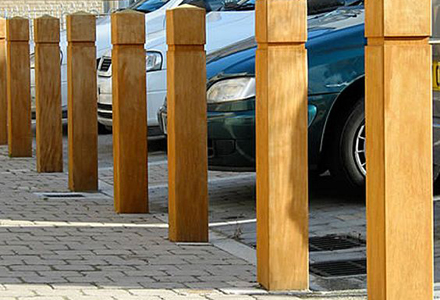
FWPA has just issued the 47th Technical Design Guide – Timber Bollards: for protection and traffic control — which is available on the WoodSolutions website. Design Guide 47 covers the types, aesthetics and use categories of timber bollards, with advice on choosing timber, installing and preserving bollards in different scenarios. Source: Timberbiz
Bollards have maritime beginnings as wharf-side posts for mooring ships, but are now common throughout the built environment. They can define space, control vehicles and people, and protect from unwelcome traffic. They can also be used for decorating and way-finding.
As security awareness increases, bollards are being used to resist threats such as ram-raid burglaries and even potential terrorist activity. External bollards represent one of the most weather-exposed uses of timber.
They are rarely maintained, yet expected to have long service lives. The selection of appropriately durable timber species and grade are important not only for the weather-exposed portion of bollards, but also that which is underground.
The guide details considerations for better bollard design and specification, so that common poor construction and inferior product substitution can be avoided. It also includes a case study from Gatton, Queensland, to illustrate the durability of timber bollards and provide a comparison with the use of plastic bollards.
Lake Apex Park, in Gatton, is a council park that was enclosed by a hardwood post-and-rail fence when the park was first developed in 1984. After more than 30 years, the hardwood bollards and fencing were still in good condition however, a key learning from the case study was that durable species selection needs to be paired with supply of timber with no heart. The guide explains the difference between sapwood, heartwood and heart, and stresses the different preservation measures needed for each.





